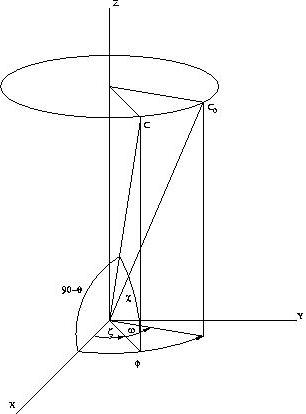Eval15 C-vector
 The c-vector is the normal of the reflection plane. The c-vector
is defined in the laboratory (xyz) system.
The c-vector has to be rotated around the rotation axis (in this figure
the z-axis) to bring it into diffracting position. This position
is reached when the angle between the incoming beam (the x-axis) and
the c-vector is 90-θ (Braggs Law).
The c-vector is the normal of the reflection plane. The c-vector
is defined in the laboratory (xyz) system.
The c-vector has to be rotated around the rotation axis (in this figure
the z-axis) to bring it into diffracting position. This position
is reached when the angle between the incoming beam (the x-axis) and
the c-vector is 90-θ (Braggs Law).
sin(θ)
cos(ζ) = ———————
cos(χ)
with χ the inclination of the cvector relative to the plane perpendicular
to the rotation axis (in this figure the xy-plane).
Note: |cos(ζ)| should be less or equal to 1.0
- sin(θ)=cos(χ)
So ζ = 0. Only one solution.
- | sin(θ) | > | cos(χ) |
No solutions. It is impossible to bring this vector into
diffracting position. These are so called cusp-reflections.
- | sin(θ) | < | cos(χ) |
Two solutions. The c-vector will diffract if the rotation angle
is set to ζ (right impact) or to -ζ (left impact).
C0 is the c-vector before any rotation. The required rotation angle
ω=ζ-φ (for right impact; -ζ-φ for left impact) will
bring C0 into the diffracting position C.
Set c-vector
There are 4 ways to set a c-vector:
- set reflection indices
Use the
hkl command to set
the reflection indices. The c-vector will be calculated
from the orientation matrix at the goniostat position. You can define the
orientation matrix with the
rmat command. If you
do not define the matrix, eval15 will calculate one
from the cell parameters (defined with the
cell command). The
default cell parameters are 10 10 10 90 90 90.
Use goniostat to define
the goniostat position.
You also have to set
left or
right.
- set impact coordinates
Use the hor and
ver commands to
set the impact position. The value of
left or
right will be set.
The walk command also
generates c-vectors from impact coordinates.
The initial rotation angle (φ in the figure) will be set
to -ζ or +ζ (for left and right impacts respectively)
resulting in a final rotation ω of 0 degrees (set
cvectorrot to
on to change this behaviour).
- set θ, χ and φ
Use the commands
theta,
chi and
phi to define
the c-vector.
You also have to set
left or
right.
- select reflection number
Use boxopen,
next or
file
to load a reflection from a boxfile.
Animation
Random
During animate)
random c-vectors will be generated if
randomcvector=on.
θ will be set to a random value between
thmin and
thmax.
Chi will be set to a random value between -90 and +90°
If θ + abs(χ) +
mosaic +
animos exceeds
the value of thetachilimit
(default 90°) new values of θ and χ will be tried.
Then φ will get a value between 0 and 180°
50 % of the reflections will impact
left and 50 % will impact
right.
Walk
With the walk command, c-vectors
will be generated from impact positions. The impact positions are
generated by stepping over the detector (with stepsize set by
step).
Eval15
Eval15 commands
 The c-vector is the normal of the reflection plane. The c-vector
is defined in the laboratory (xyz) system.
The c-vector has to be rotated around the rotation axis (in this figure
the z-axis) to bring it into diffracting position. This position
is reached when the angle between the incoming beam (the x-axis) and
the c-vector is 90-θ (Braggs Law).
The c-vector is the normal of the reflection plane. The c-vector
is defined in the laboratory (xyz) system.
The c-vector has to be rotated around the rotation axis (in this figure
the z-axis) to bring it into diffracting position. This position
is reached when the angle between the incoming beam (the x-axis) and
the c-vector is 90-θ (Braggs Law).